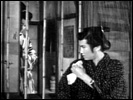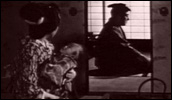Swords in the Moonlight
- Year
- 1957
- Original title
- Daibosatsu Toge
- Japanese title
- 大菩薩峠
- Director
- Cast
- Running time
- 119 minutes
- Published
- 16 March 2008



by Dean Bowman
The Swords in the Moonlight trilogy (a.k.a. The Killer Pass) by the neglected Tomu Uchida will seem uncannily familiar to anyone who has seen the better known Sword of Doom by Kihachi Okamoto. This is hardly surprising considering that both stories, as their shared Japanese title of Daibosatsu Toge (usually translated as The Great Buddha Pass) suggests, are adapted from the same source: Kaizan Nakazato's epic and influential 41-volume historical novel of the same name. What is surprising is just how closely the two follow the same narrative thread, whilst simultaneously diverging utterly from one another on the level of style. Made in 1966, Okamoto's abstract, existential meditation could not be any more different from Uchida's lavishly staged melodrama made almost ten years earlier.
Curiously it is Uchida's earlier films that sport the newly adopted colour film system, whilst Okamoto opts for an austere, high-contrast black and white to express his theme of alienation. Although he refused to relinquish the film rights until 1935, Nakazato's novel has exerted a huge influence on the samurai genre, spawning many adaptations. Nakazato's protagonist, Ryunosuke Tsukue, forms the archetype for the nihilistic, amoral ronin who appeared frequently until well into the sixties, when the genre began to be left behind.
Thus both films begin with Tsukue arbitrarily killing a pilgrim traveling with his granddaughter across the ill-fated titular pass, before backing up this callous act by killing a rival during a fencing match after seducing his wife. Having little choice, she follows him as he flees from the village and later bears him a child. Meanwhile the granddaughter of the murdered pilgrim is taken in by a kindly old man, whilst the brother of the slain man, Hyoma (Nakamura), swears vengeance, kicking off a long meandering tale of revenge traversing the length and breadth of Edo-period Japan in an episodic structure similar to Kazuo Koike's Lone Wolf and Cub manga (Nakamura's most famous role is in fact that of Itto Ogami in the TV adaptation of Koike's manga). Chance has a key role in the film's narrative; with Hyoma several times crossing paths with the girl or coming upon Tsukue's trail by dumb luck rather than detection, to the point where the whole thing seems ridiculous. Rather than poor storytelling this only serves to reinforce the sense of fatalism that drives Tsukue towards his inevitable doom.
Both films, then, retain the protagonist as a feckless, opportunistic killer about as antithetical to the bushido warrior as is possible, although Uchida's adaptation allows him to develop a slither of humanity as he longs to be reunited with his son and for occasional, often accidentally, benevolent acts. Tsukue is played here by veteran actor Chiezo Kataoka, who in later years appears in Eiichi Kudo's masterful and thoroughly underrated The Great Killing; his dirge-like, monotone voice and mask-like face lend the character the supernatural qualities of a kabuki protagonist. Contrastingly, in Okamoto's version the great Tatsuya Nakadai gives a brooding, taciturn performance, which seems to recall the figure of Mersault in Camus's L'Étranger, thus demonstrating the extent of the influence of European culture on Okamoto's generation of filmmakers.
The famous film critic Tadao Sato has commented on the Sword in Moonlight's Buddhist undertones, largely drawn from the novel, reading Tsukue's character as an incarnation of Buddhist ideas of suffering. This is reinforced by the film's occasional moments of delightful abstraction, when the walls of a palanquin or brothel suddenly blow apart, setting Tsukue suddenly in silhouette against a red background. The credit sequence also gives the film an overtly religious frame, as the camera pans down a tapestry from Nirvana to a depiction of the Buddhist underworld, and then back upwards again at the end of the third film, suggesting a cycle of reincarnation. Made in more secular times, Okamoto's Sword of Doom leaves out the story's religious subtexts in favour of an exploration of newly imported European philosophies of existentialism. However, both directors explore, in their own way and in a mode suited to their generation, and through the character of Tsukue, the horrors of the recent war in which they were both combatants (Uchida himself spent time in a Manchurian internment camp).
Of course the biggest difference between Uchida and Okamoto's versions of Daibosatsu Toge is that Okamoto's adaptation remained unfinished, the film abruptly breaking off at the end of the first act literally in medias res - a sword strike captured in freeze frame inches from Tsukue's head. Of course the practical reason for this abrupt ending was a lack of financing to continue what was essentially a very uncommercial artistic endeavour, but this ending now seems an eerily appropriate way to leave Okamoto's absurdist protagonist, floating somewhere between life and death, frozen forever on a strip of celluloid in a limbo of uncertainty. Whilst Uchida's protagonist suffers a similarly arbitrary death, it is one far better suited to the melodrama than the absurdity of Nakadai's demise.